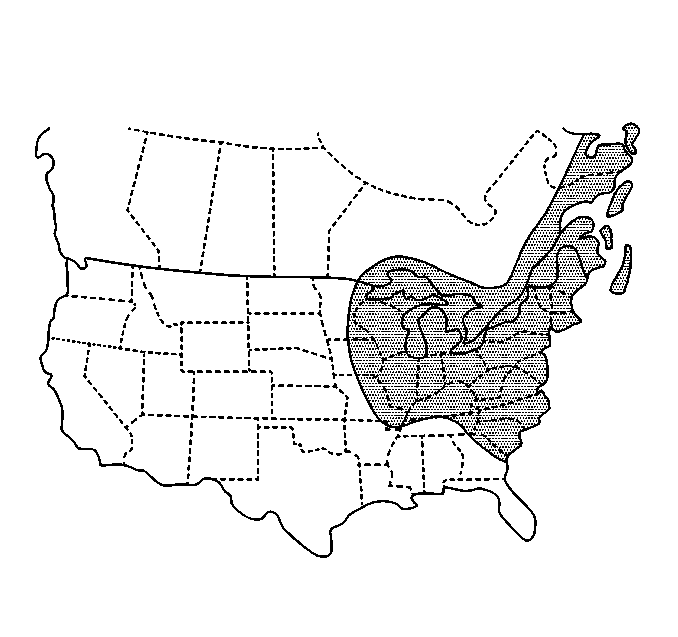Steering and Suspension Inspection
Inspect the front and the rear suspension for the following:
| • | Damaged parts |
| • | Loose or missing parts |
| • | Signs of wear or lack of lubrication |
Inspect the power steering lines and the hoses for the following:
| • | Proper hookup |
| • | Binding |
| • | Leaks |
| • | Cracks |
| • | Chafing, etc. |
Tire and Wheel Inspection
Inspect the tires for uneven wear or damage. If there is irregular or premature wear, check the wheel alignment. Inspect for damaged wheels. For tire diagnosis information, refer to Tire Diagnosis - Irregular or Premature Wear in Suspension.
For wheel alignment diagnosis information, refer to Preliminary Alignment Inspection in Suspension.
Exhaust System Inspection
Inspect the complete system. Inspect the body near the exhaust system. Look for broken, damaged, missing or out-of-position parts as well as open seams, holes, loose connections or other conditions which could cause a heat build-up in the floor pan or could let exhaust fumes into the vehicle. For exhaust system inspection diagnosis, refer to Engine.
Engine Cooling System Inspection
Caution: NEVER spray water on a hot heat exchanger. The resulting steam could cause personal injury.
Notice: Compressed air or water can be used to clean the radiator fins. Do not exceed 138 kPa (20 psi). Pressure over 138 kPa (20 psi) will damage the radiator.
Inspect the hoses and replace if they are cracked, swollen or deteriorated.
Inspect all pipes, fittings and clamps; replace as needed.
Important: The radiator and A/C condenser should be kept clean for proper system performance. Cleaning is recommended at least once a year.
Inspect the front surface of the radiator and A/C condenser. Insects, leaves, debris, etc. can affect the performance of the radiator and A/C condenser.
If the front surface of either or both of these components is found to be in need of cleaning, the unwanted material can be removed by performing the following:
| • | Ensure that the engine is off and cool. |
| • | Blow compressed air through the radiator from the rear surface of the radiator toward the front of the vehicle. |
| • | If compressed air is not available, use a water hose to force water through the radiator from the rear surface of the radiator toward the front of the vehicle. |
To help ensure proper cooling system pressure performance, a pressure test of the cooling system and pressure cap is recommended at least once a year.
Throttle System Inspection
Throttle system (includes accelerator and cruise control) should operate freely without hesitation between full closed and wide open throttle.
Important: The accelerator and cruise control cables should not be lubricated under any condition. Throttle system components causing hesitation or sticking should be replaced.
Inspect the following:
| • | Missing parts such as retainers or clips. |
| • | Interference of the linkage or the cable conduit to critical components such as fuel lines, brake lines, harness leads, etc. |
| • | Proximity of the cable to the exhaust system and other heat sources: check for melting and/or discoloration. |
| • | Cable kinking. Avoid sharp bends of cables. |
| • | Clearance of the throttle system moving parts throughout their travel from other stationary components. |
| • | Damage of the components due to cable kinking, severe kinking, severe abrasion, misalignment, etc. If any of the above conditions exists, notify your dealer for a recommended rerouting, adjustment, or replacement. |
Brake System Inspection
Inspect the complete system.
Notice: A low brake fluid level can indicate worn disc brake pads which may need to be serviced. Also, if the brake system warning light stays on or comes on, something may be wrong with the brake system. If the anti-lock brake system warning light stays on or comes on, something may be wrong with the anti-lock brake system.
Inspect the brake lines and the hoses for the following:
| • | Proper hookup |
| • | Binding |
| • | Leaks |
| • | Cracks |
| • | Chafing, etc. |
Inspect the disc brake pads for wear. Inspect the rotors for surface condition. Inspect other brake parts, including the calipers, the parking brake, etc.
The brakes may need to be inspected more often if driving habits or conditions result in frequent braking.
Caliper/Knuckle Maintenance Inspection

If the vehicle is operated in a highly corrosive environment, as indicated by the shaded areas on the map, the vehicle may require additional brake service. Refer to the appropriate GM Service Bulletin for the proper caliper inspection procedure. As necessary, caliper pins and knuckle brake pad abutments should be lubricated at every other tire rotation. Also see a GM retailer's service department or qualified service center for additional information.
